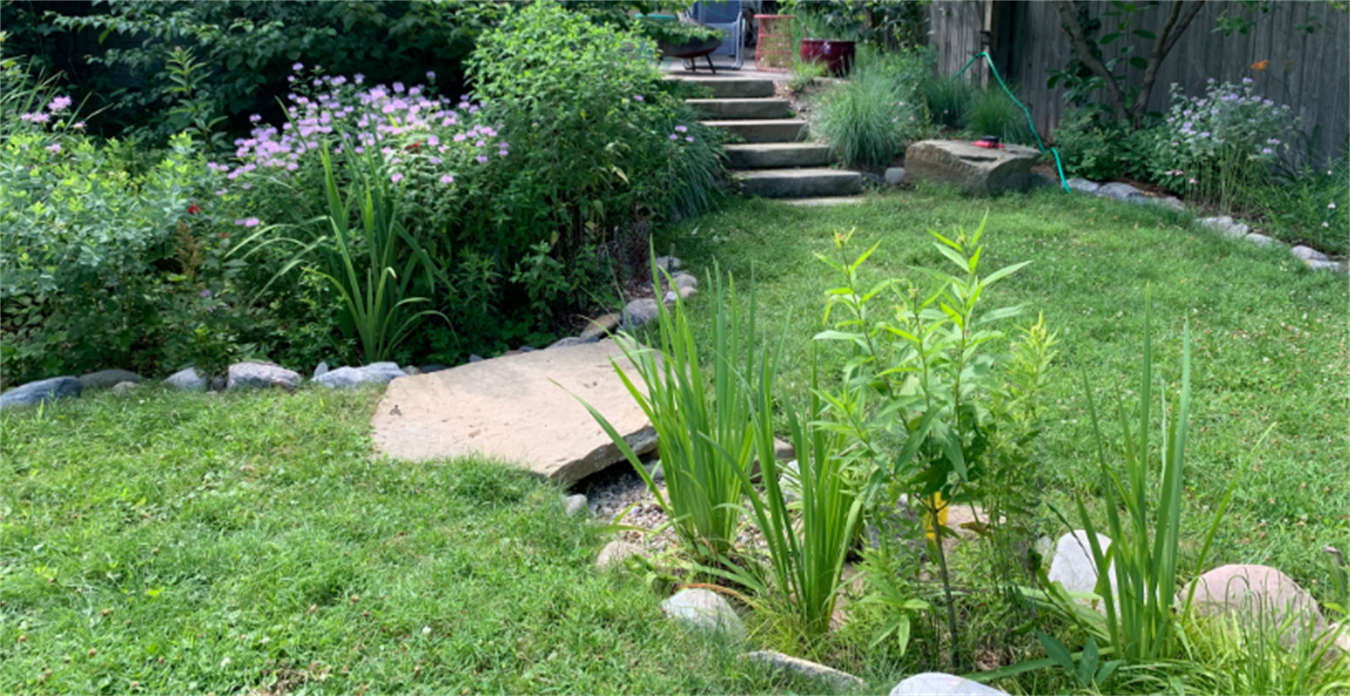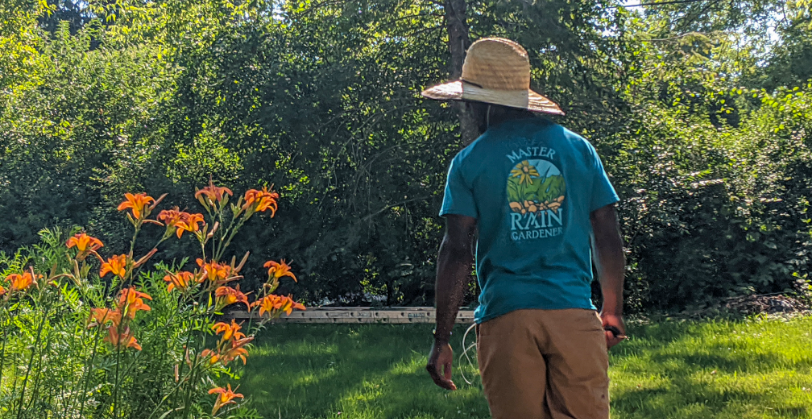
Rain Gardens
Rain gardens are attractive landscaping features that double as areas to allow rain and snowmelt to make their way into the soil. Depressions, where water migrates, are planted with deep-rooted native vegetation, thereby allowing the soil to absorb excess rainwater runoff from a house or other impervious area. Rainwater is routed to the garden and filtered naturally by the plants and soils there. This filtration process removes nutrients and pollutants.
Learn how to save money by installing a rain garden.

About Rain Gardens
- Your rain garden can be constructed in the front or back of your yard.
- Front-yard rain gardens can be placed to intercept runoff from paved surfaces or from a downspout.
- Backyard gardens can be situated in any wet area that collects drainage or an area where you can direct runoff from a downspout.
- Keep the rain garden at least 15' away from foundations and let the downspout end at the outside edge of the garden. Your garden should be about one-third of the size of the surface area providing the runoff.
- You should make a depression 3 to 4 inches deep throughout the area of the garden.
- The soil in your rain garden should allow fast infiltration of water. This can be done by mixing about 30% compost with your existing soil. This mixture will allow excellent root growth and recharge of water.
- Hardy native species that thrive in our ecosystem are the best choice for your rain garden. Native plants will tolerate wet conditions as well as periods of drought.
- Many rain gardens feature shrubs as well as wildflowers and grasses.
- You can also choose plants that attract local birds and insects.
- Large rain gardens generally contain at least 15 different species of plants at a density of one per square foot.
- For smaller gardens, a variety of perennials and shrubs makes a good mix.
- As the rain garden matures, you will need to thin the population of some plants as others grow.
Here is a list of plants for local rain gardens.
- In the weeks following planting, you should remove weeds until the plants are strong.
- For the first year, your rain garden will most likely require monthly weeding during the growing season.
- In following years, weed one time per year and replace mulch to retain moisture.
- Shrubs need to be pruned annually.
- During extremely dry periods, it may also be necessary to water several times per week.

Design your own rain garden!
Become a Master Rain Gardener through our partnership with the
Washtenaw County Water Resources Rain Garden Program. Check out what master rain gardeners around town are doing in the
Washtenaw County Master Rain Gardener Facebook group.
A few things to know about designing and installing your own rain garden:
- Rain gardens are relatively easy to start.
- The most difficult work may be removing existing grass and plants.
- Most gardens are created by digging a shallow depression in the landscape.
- Soil and sand or gravel, or organic mulch, is used to layer into the garden plot.
- Hardy native plant species with deep root systems are preferred for a rain garden, but trees and shrubs can also be used.
- The rain garden is practical in landscaped areas along driveways or walks, corner pieces to the yard and in receiving areas for roof downspouts.
Rain gardens for kids
Involve your kids and learn about rain gardens together. Download the Stormwater Smart rain garden coloring page!
Stormwater utility credit
Installing a rain garden can result in a savings of $8.10 per quarter. The requirements for this stormwater utility credit are:
1)
Roof drainage of at least 50% of your property’s roof area (at least half of your home’s downspouts) should drain to the rain garden OR the rain garden must capture runoff from an impervious area on your property that is equal to 50% of your roof area.
2)
Size
3)
Vegetation
Rain gardens must have plenty of plants to absorb stormwater runoff and snowmelt.
Native perennial plants are the best for soaking up and filtering the most water possible (also called infiltration).
4) Infiltration
Within 24 hours, your happy rain garden should be drinking up and cleaning that stormwater. Testing the ground must take place before installing:
Dig an 18-inch hole and fill it with water.
Let it drain.
Fill it again. If the second time it takes less than 24 hours to drain, the soils are adequate for the rain garden.
Other recommendations
The rain garden should be kept at least 15 feet away from foundations and should overflow safely.
In case of a large rain event, it is important to provide a way for excess water to drain out in order to prevent flooding of your garden.
Overflows should not go directly to a sidewalk, steep slope, retaining wall or to a neighbor’s property.
You can use peat moss in addition to compost to increase moisture retention.
To increase the visits of songbirds and butterflies, incorporate berry- and nectar-producing plants.
Leave the dead or dormant plants standing over the winter. Many of the plants will provide seeds and shelter for birds. In the spring, cut back or mow the stalks to allow new shoots to emerge.
To obtain a stormwater utility credit, please submit a
Rain Garden Stormwater Utility Credit Application once you have installed your rain garden. For any questions, please email
[email protected].
Resources
Ways for you to make a big difference by being Stormwater Smart.
If you don’t have fun doing important work, the important work may not get done. So, we work hard at coming up with fun ways (seriously) for you and your family to be Stormwater Smart. Each person has the potential to not only change their own behavior but also to influence other community members.
Get Stormwater Updates
Sign up for Stormwater and City of Ann Arbor updates.
